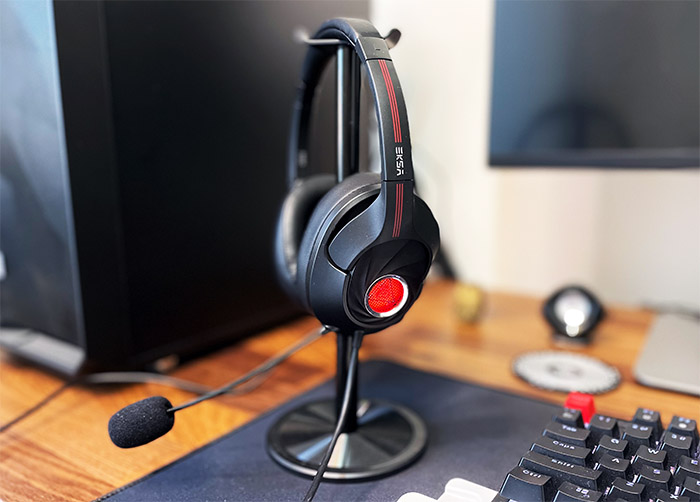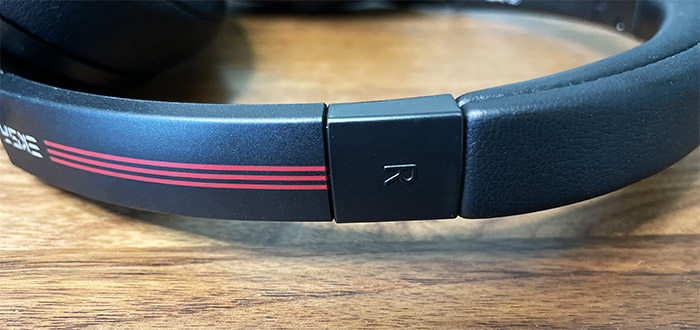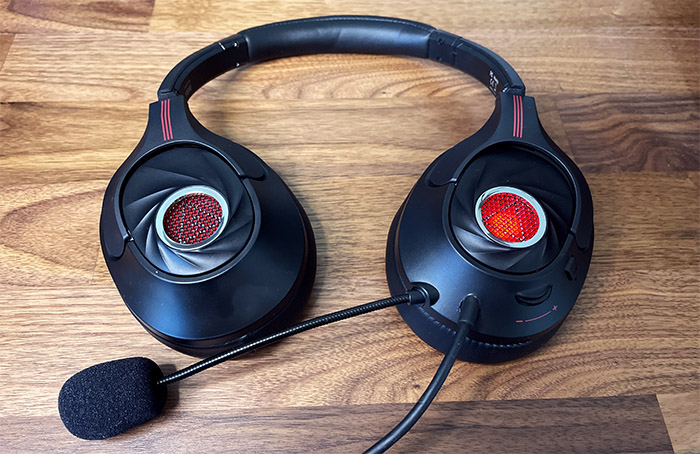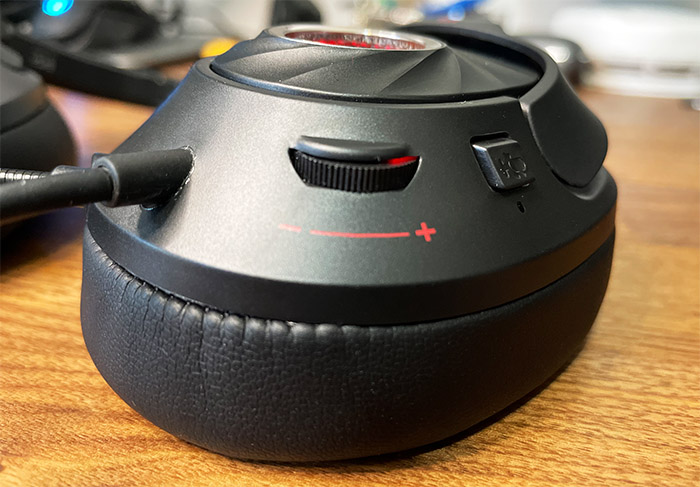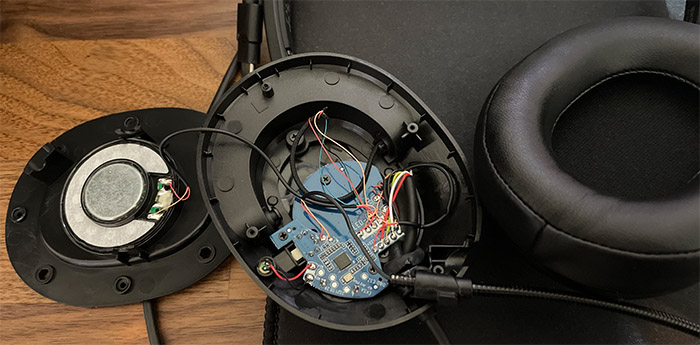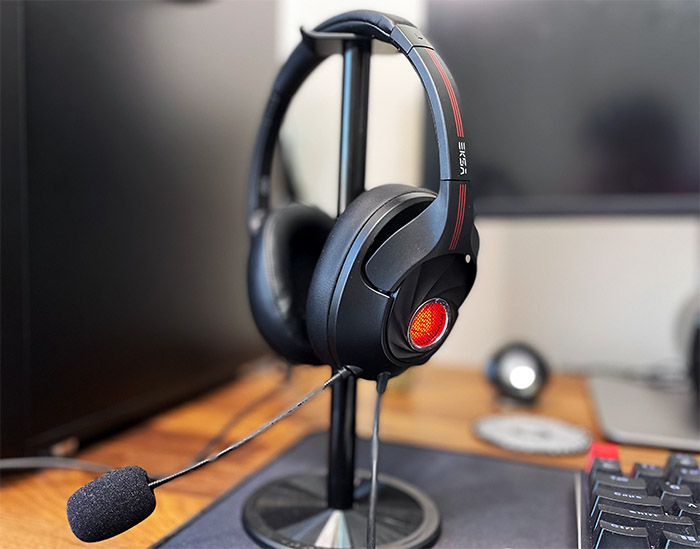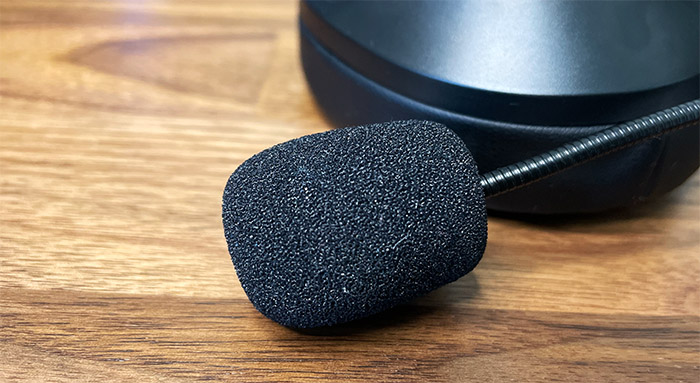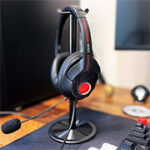The EKSA Air Joy Plus is one of the more affordable gaming headphones released by the Chinese manufacturer and we’re dealing with 40mm speakers that have a 32 Ohm impedance; there’s also a USB-C connector, so the Air Joy Plus is compatible with a large array of devices.
| EKSA Air Joy Plus | |
|---|---|
| EKSA.net | Check Offer |
I noticed that the main target is the Nintendo Switch users, but it will work with smartphones, PCs, laptops and other gaming devices as well. Furthermore, the EKSA Air Joy Plus also has a microphone (with a separate windscreen) which is easily adjustable and the manufacturer says that the headphones come with a driver-free 7.1 surround sound. Don’t think that you’ll get multiple speakers inside the headphone earcups, we’re just dealing with virtual surround sound which is still interesting for an inexpensive device.
At the same time, the gaming headphones market has always been kind of weird, with the focus more towards the looks than the sound quality itself and yes, you don’t need audiophile level sound to play games, but a wide sound stage and an accurate imaging will definitely help a lot in competitive gaming. Surely, the EKSA Air Joy Plus don’t lack in terms of looks (it has a pulsating LED on the earcups), but I am curious whether the manufacturer has managed to create a balanced sound experience and if it’s actually going to be useful in competitive games, so let’s put the headphones to the test.
Build Quality and Design
EKSA has introduced the Air Joy Plus as being ultra-light and I have used a couple of lightweight headphones over the years (such as the Sony WH-1000XM3 and the AKG K240 Studio), but, at their 7.2 ounces (204 grams), the EKSA Air Joy Plus are indeed the lightest pair of headphones that I tested so far. And this does mean that there are a few compromises in the build quality department. In order to keep a pair of headphones lightweight, the manufacturers usually use some cheap plastic with as little metal as possible. That was the case with the Sony’s which are terrible in terms of long-term durability, while the K240 feels far more robust, but I did got them only a few months ago, so I can’t yet comment on their ruggedness.
The EKSA Air Joy Plus do feel very similar to the Sony WH-1000XM3 and that does mean that the manufacturer did not use the best type of plastic and no, the headphones do no feel sturdy. I was actually a bit worried about the headband since the frame is fairly small (clearly suitable for children or adolescents), but to my surprise, it held really well even if I stretched it almost completely flat. The slider is metallic and it’s easy to operate, but do be careful with the arms and other plastic joints because they (again) don’t feel that sturdy.
The headband is fairly narrow and it has a layer of soft cushion which could have been a pressure point with other headphones, but the EKSA Air Joy Plus are light enough to not cause issues for a few hours of use. Furthermore, I did like that there was no pressure on the jaw (as I saw on the OneOdio Monitor 60), so yes, the earcups aren’t heavy or large. And the cushions are soft, but it’s worth mentioning that they barely managed to cover my ears. The earpads could have been a bit larger, but then again, after pushing the slider to the maximum, I did get a full cover of my head and ears – with some noticeable pressure at the top of my head. The target audience seems to be the younger people and the EKSA Air Joy Plus will most likely fit a smaller head better.
Just like with the EKSA GT1 TWS earbuds, there is a heavier focus on the gaming look, so the vortex-like design on the earcups will not take anyone by surprise, but I did see a metallic mesh in the middle and I thought for a brief moment that maybe we’re dealing with an open-back pair of headphones. The Air Joy Plus are closed back, but there is a red LED that pulsates from underneath the mesh, which will undoubtedly attract the younger gamers. I would have liked to see an LED on/off switch because there is no way to turn the red LED off and it does get annoying if you sleep in the same room as your computer (you will need to disconnect the headphones).
There is an R and an L written on the earcups, but you will know the right way to put them on your ears due to the microphone. There is a fairly long mike arm that’s covered by a metallic cover and will allow you to position it however you prefer. There is also a windscreen to help with the clarity of the sound. I did see that the 6.6 feet headphones cable is permanently connected to the right earcup and, if your computer lacks a USB-C port, EKSA has added an extension in the package that will convert it to USB-A. Besides the cable connection, there are a few controls on the left earcup, the first is a button that mutes the microphone and the other is the volume wheel. The latter rotates very smoothly and it’s easy to access and operate.
Internal Hardware
The EKSA Air Joy Plus uses 40mm dynamic drivers with the impedance at 32 Ohm (+15%), so they can be driven by pretty much any sources – the sensitivity is rated at 92+3dB/mW. Since everything was held together by small screws, I have opened the left earcup to check some of the components and I was able to identify the NanoSic WN8031F SoC chip which integrates a CK804 CPU, flash and audio functions. There is no support for Bluetooth and that’s for the best when it comes to gaming because I have not found any pair of headphones (especially the budget-friendly ones) to be able to offer a low latency. So yes, the EKSA Air Joy Plus are wired only and I would have liked to be able to change the cable, but considering the price tag, I suppose they cut some corners in this regard (it won’t really affect the user experience).
Sound Quality
Like I said in the intro, gamers don’t care for audiophile sound, but they do care for the ability of a headphone to accurately reproduce sound in a simulated environment, so a good sound stage (as wide as possible) and proper imaging is necessary. The first set of tests is in regards to the technical behavior of the drivers, so I ran a quality test and it was not bad at all, the sweeping sound was fairly clean, with little to no buzzing. The driver matching test revealed there is some deviation, so the drivers aren’t perfectly calibrated to work with each other. Afterwards, I listened to a binaural song and the sound stage was alright, although a bit narrower than the AKG K240 (which is a tiny bit more expensive – well, almost double the price), but still decent, since I could tell when a person was close or in the distance.
But the position of the instruments was a bit vague, especially the guitar – the piano was slightly better defined and the cello + violin were the clearest. Moving on to listening to some songs, I started with ‘Zhu – Faded’ to get an idea about how the headphones handle low bass. And it is fuller than expected, but, at the same time, it was kind of muddy and I also noticed that the mids were pushed in the back (and somehow echo-y), while the highs felt muted. I saw the same thing with ‘Morph The Cat by Donald Fagan’, where the mid bass covered the mids, which were again pushed back, so I did try another type of song, ‘To The Hills – Laurel’, the Solid Stone’s Deep Interpretation which is quite different from the original.
I noticed a fairly decent, fuller bass representation (than the K240 which do lack in this department), so the headphones seem to have been fine tuned to cater to the EDM and bass heads out there. Moving on, I checked ‘Sofi Tukker – Déjà Vu Affair’ and the multiple bass beats seem muddy, the voices are pushed backwards and overall, it just doesn’t sound exciting – it’s not exciting with the K240 as well, but at least everything is far better defined. The song ‘She Burns’ by Vance displayed a similar behavior, where the the voice seemed distant and pushed in the background, while the highs felt muted. The guitars in ‘Guns-n-Roses – Sweet Child o’Mine’ seemed to have no substance, so I raised the volume in the hopes of reaching a more exciting sound, but besides the bass that gets more dominant, the voices just aren’t there, they’re again pushed far back.
‘Caribou – Bowls’ was just not as clear as with other headphones, the differentiation between the instruments is less obvious, the sounds seemed to get over each other.
Lastly, I checked the level of sibilance by listening to ‘Empire Of The Sun – Alive’ and it’s fairly severe since some lyrics were barely clear. So yeah, they’re not audiophile level which comes at no surprise to anyone, especially with the focus on bass (up to certain degree). Still, considering the price tag, these are all expected weaknesses and the sound signature is very similar to other budget-friendly headphones that are tuned for the mainstream music.
Microphone Quality
The EKSA Air Joy Plus uses a microphone that has the sensitivity at -38+/-3dB, it’s unidirectional and the maximum current is set at 0.5mA. When you’re a competitive gamer, sound is important, but to be able to be clearly heard by your teammates, you do need a proper mike as well.
The good news is that the EKSA Air Joy Plus has a decent microphone, but its performance is heavily dependent on the way you position it. If the microphone is right next to your mouth, then the sound is going to be clear, but move it a few inches out and the quality drops by 20-30%. The manufacturer says that it uses the ENC technology which should not be mistaken for ANC, but it does work in a similar fashion since it does block out some of the environmental noise, while keeping your voice into focus. I did test this claim with various taps and noises, but it seems that the person on the other end of a call could only hear my voice and nothing more. So it does indeed work as intended. At the same time, do be aware that passive noise canceling is pretty much non-existing, so you will be able to hear everything that’s going on around you.
The Conclusion
EKSA perfectly understands its target audience, the younger generation of gamers which is easily captivated by a cool design and some LEDs, so the EKSA Air Joy Plus will definitely capture their attention. The build quality is not that impressive, but, considering the price tag, it’s as expected; the microphone works really well and I found the Air Joy Plus to be very comfortable to wear for a long time (they’re very lightweight). The sound quality is, again, in line with what’s expected from a very budget-friendly pair of headphones, so there’s a focus on the bass, while the mids and highs are not that well defined (muted and distant). You’re not really going to find a great sound under $50, so, at this point, you may as well give in to the cool design and LED lights and give the EKSA Air Joy Plus a chance.

